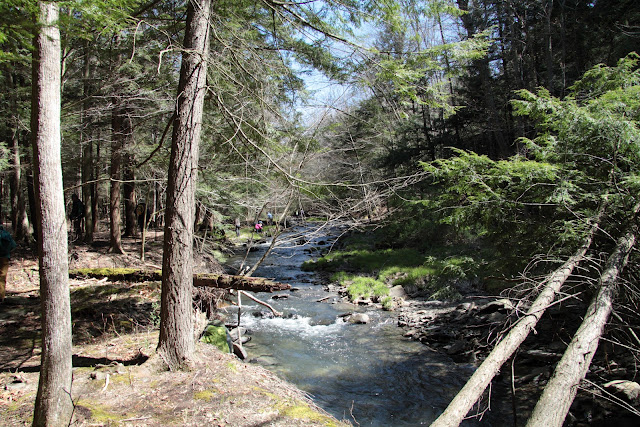We began our day along Six Mile Creek, a body of water near and dear to the City of Ithaca since it provides our drinking water.
We broke the record for number of spring salamanders found in a trip. Spring salamanders are in the same family as redback salamanders: Plethodontidae, or lungless salamanders. They are nowhere near as common as the redbacks and they are more likely to be in creeks rather than under logs, making them harder to find.
Adult spring salamander, Gyrinophilus porphyriticus
Young spring salamander- notice the gills
While searching the creek, we also found several aquatic adult red spotted newts, Notopthalmus viridescens. You may be familiar with their juvenile form, the brightly colored terrestrial red efts.
Adult red spotted newt
We also flipped rocks and logs near the creek and found plenty of other critters. We saw lots of redback salamanders and also several dusky salamanders. Two species of dusky salamanders (also in the family Plethodontidae) inhabit this part of the country. Ironically, the common dusky salamander, Desmognathus fuscus, is highly uncommon here. The mountain dusky salamander, Desmognathus ochrophaeus, is much more common. It is nearly impossible to tell the two species apart.
Dusky salamander
Our first reptile of the day showed up next to Six Mile Creek.
Garter snake, Thamnophis sirtalis
The site included several vernal ponds. You may remember from our salamander migration post that spotted salamanders (Ambystoma maculatum) and Jefferson's salamanders (A. jeffersonianum) breed in vernal ponds during the early spring. We saw several egg masses in these ponds, and Anna valiantly fished one out for a closer look.
Eventually we climbed up the hill to new habitat and found a beaver pond that held several more red spotted newts.
On a nearby ridge several snakes were busy sunning themselves, including a garter snake with an especially pretty pattern...
... and the find of the day! A smooth green snake, Opheodrys vernalis!
This little guy or girl completely made the day. Smooth green snakes are a species that we rarely see during our herp surveys, so finding this one was a fantastic way to end the trip!
Final species count (this is only a partial count since it was hard to keep track of so many herpers' finds)
Redback salamander, Plethodon cinereus: 23 (2 leadback phase)
Dusky salamander, Desmognathus sp: 14
Two-lined salamander, Eurycea bislineata: 10
Spring salamander, Gyrinophilus porphyriticus: 4
Green frog, Rana clamitans: 3
Wood frog, Rana sylvatica: many tadpoles
Spring peeper, Pseudacris crucifer: heard many
Spotted salamander, Ambystoma maculatum: egg mass
Garter snake, Thamnophis sirtalis: 4
Smooth green snake, Opheodrys vernalis: 1
Unidentified turtle: 1
Photos: Jessica Tingle
Post by Jessica Tingle


















No comments:
Post a Comment